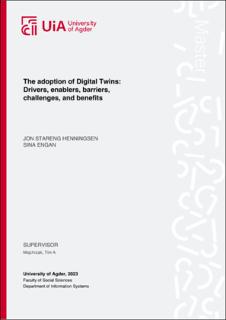| dc.description.abstract | The Fourth Industrial Revolution provides a wave of smart innovative technologies, where the Digital Twin is one of them. A Digital Twin is seen as a digital replica of a physical asset, process, or system, allowing real-time monitoring, simulations, and analysis for better decision-making. Despite its benefits, few have implemented Digital Twins and begun utilizing its value. Thus, this thesis investigates how organizations can get started with a Digital Twin by looking at the different elements of the implementation process.
A systematic literature review was conducted to obtain a background foundation of Digital Twin adoption. The review aimed to identify what existing research had found as drivers and enablers, barriers, challenges during implementation, and benefits provided by a Digital Twin. To provide new research on the field, we followed a qualitative research method. Through 19 semi-structured interviews of Digital Twin experts, findings indicate that factors driving and enabling Digital Twin adoption include data access, staying competitive, improved asset management, and management support. The study also shows that costs, competence, and lack of incentives are the most significant challenges related to the implementation. Furthermore, it is important to be aware of your own needs and what you want the Digital Twin to solve, in order to measure a successful implementation. Interviewing experts with Digital Twin experience identified benefits such as proactive maintenance, improved decision-making, simulations, and increased efficiency. This study contributes to valuable perspectives on Digital Twin knowledge and its implications. Practitioners can use these findings to achieve awareness and knowledge related to implementation challenges, and further use this theory to see how the benefits of a Digital Twin can be realized. | |
